The Seven Years War British Grenadier
 |
| The Seven Years War British Grenadier naked metal casting |
This article describes the painting of a Seven Years War British Grenadier figure for miniatureswar gaming.I am a member of the Lone Star Historical Miniatures groupin Austin, Texas, and a call-for-painters was made on our Yahoo LSHMAustin Grouplist.Tom Primrose of Grenadier Books was looking forpainters to paint theirLimited Edition 28mm Seven Years War British Grenadier figure.Several painters responded, and I was one of the lucky 3 painters to get a commission topaint the figurealong with Dave Beeson of LSHM and Ioannis Mavromichalis of Wargames-etc.The figure was sculpted by Tony Aldrich and casted by Historifigs.As you can see, it is an interesting British grenadier red-coat with a large mitre cap reading a book.
 |
| The figure is primed |
The previous naked metal photo is a bit difficult to appreciate, but this pictureshows the figure primed with gray paint and looking like a clay sculpture.Impressive.Lots of detail in the uniform and a unique pose of a battlefield warrior reading a book.As you can see, the 1 to 2 mm thick base brings the top of the figure's skull up to the 28 mmheight.The impressive mitre cap brings the total model height to almost 35 mm.As this is my first Seven Years War figure and most of my painting is in the Dark Ages, I didquite a bit of research before painting.I eventually found nice reproduction reenactment gear at the The Seven Years War Websiteincluding a good close view of the British Grenadier mitre cap.It is simply amazing to me that there were regiments with such a beautiful and expensivecap when today such a cap costs $400.How the British army afforded so many caps, coats,kit, rifles, shoes and leggings,costing so many days wages, is nearly beyond my comprehension.
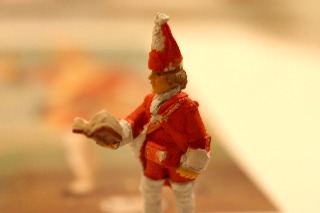 |
| Basic colors blocked in |
Here is a photo of the first stages of painting.The eyes are painted first, then the basic flesh undercoat, then thered of the outer coat.Although I knew that there would be multiple painters for this project,none of the painters knew what the others would do.I was surprised that all the painters came up with the same basicred for the coat and buff for the cuffs and cap.For me, never having painted a red coat before, this was one of my worries - thatI would pick the wrong red for the coat.Many 18th and 19th century gamers are very particular about getting thedetails and the colors on the figure exactly correct.
 |
| More details added - rear shot |
Here is a rear view of the early stages of painting.As you can see, there are buff-yellow cuffs and turned-up edges to the red coat.There are a few black leather pouches and a fur knapsack on the back.The epaulettes and cuffs have a bit of gold embroidery.The book is an interesting feature for a military miniature.I imagine some sort of military manual for officers,and so I have painted it with text and a few diagrams.It seems that maneuver and firing of the 18th century,especially between the French and British armies,was much more doctrine and formula than the battles of this past century.
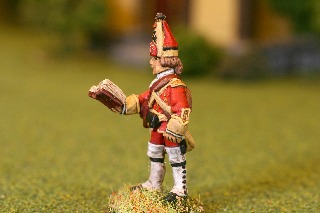 |
| Completed side view of miniature |
Following more detailing and a dip into dark brown wash, here is a photo of my completedfigure.He is a nice bright eyed figure, with excellent wardrobe. I particularly like theleggings and the mitre cap.For me this has been a wonderful foray intoa historical period outside my usual.
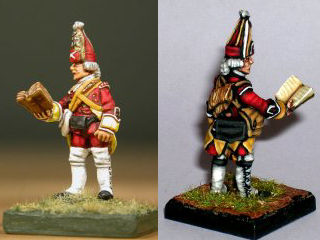 |
| Dave Beeson and Ioannis Mavromichalis' version of the British Redcoat |
The 3 selected painters have diverged in painting the cap.I have had a good look at the back of the re-enactor's cap and chosenbuff facing, red wool back, buff border, black piping,and black and white embroidery.Update: At first I thought the other painters haveguessed at the mitre color scheme, but I received this information fromone of the other painters Ioannis Mavromichalis:During the Seven Years War, almost each British regiment hadits own design of grenadier mitres with different devices, mottos, andcolors; buff being only one of them...the same applied to facing colors inlapels and cuffs...I did not guess the design I used on my grenadier, Ijust picked another regiment
Thanks for writing and setting me straight!Another area in which the 3 painters have diverged are the hair color and the figure bases.I decided to paint a young officer with brown hair. The other paintershave painted an older officer with white powdered wig.Additionally, the 3 bases are different. I have made a round baseon thin U.S. penny, while the others have chosen thicker square bases.My painting is mildly shaded.The painting of Ioannis Mavromichalis is heavily black-lined.I am not saying one or the other is better, but the different stylesdefinitely show through here.
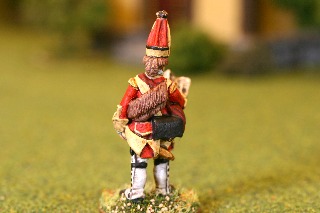 |
| Completed rear view of figure |
Here is the back of the completed figure.He has a very nice coat, fur back pack, and black leather pouch.In those days, bullets were not yet invented.Soldiers used cartridges consisting of a paper cylinderencasing a measured charge of black powder.The soldier chewed open the paper and dumpedthe powder into the muzzle.Once the powder was dumped, a round ball wasinserted, and a ram rod packed the load to the back ofthe barrel.The gun was cocked, aimed, and fired,firing the ball and releasing a big puff of white smoke.A good soldier could fire two shots a minute.
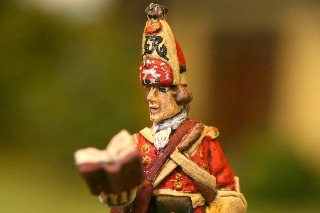 |
| Close up of completed figure |
Here is an extreme close-up of the Grenadier's face.I have attempted to reproduce the white horse and lettering and the fancyblack "G. R." initials - "George Regent," the king of Britain at the time.I painted the lettering with brush.Other painters have much success with white and black technical pens.Thanks for reading the article.I thoroughly enjoyed painting my Seven Years War British Grenadier figure,and I hope you enjoyed reading the details of its construction and painting.More miniatures-related articles are atDan Becker's Miniatures and Models site.Thanks for stopping by and reading about my miniatures.








